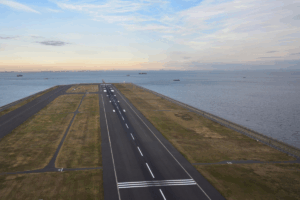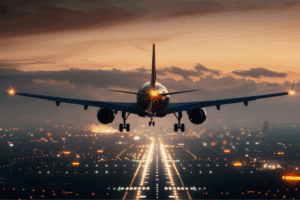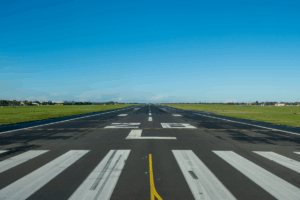Las condiciones meteorológicas extremas pueden producirse en cualquier momento, en cualquier lugar y con distintos grados de severidad. Los efectos de las inclemencias meteorológicas en las luminarias, el cableado, los equipos de control y otros componentes del alumbrado de los aeropuertos pueden ser devastadores para las operaciones normales, afectando significativamente a la capacidad del sistema para garantizar la seguridad en las pistas de aterrizaje y despegue y en las calles de rodaje.
Aunque no hay forma de evitar que se produzcan fenómenos meteorológicos extremos, los operadores aeroportuarios pueden tomar medidas para ayudar a mitigar los efectos en sus sistemas de iluminación de pistas. Sin embargo, primero es esencial entender cómo la nieve, la arena, las fluctuaciones de temperatura y otras condiciones y eventos relacionados con el clima pueden afectar a su infraestructura de iluminación de pistas.
¿Cómo pueden afectar las condiciones meteorológicas extremas al rendimiento de los sistemas de iluminación de las pistas de los aeropuertos?
Uno no esperaría que un aeropuerto situado en un lugar septentrional se enfrentara a la misma amenaza meteorológica que uno que opera en un desierto, pero, de hecho, tienen un enemigo común: los vientos de alta velocidad.
El viento puede arrastrar nieve o arena por todas las rendijas expuestas del sistema de iluminación de su aeropuerto, obstruyendo las piezas mecánicas o provocando cortocircuitos en los componentes eléctricos. Además, la nieve y la arena arrastradas por el viento pueden amontonarse delante de las balizas de la pista, comprometiendo su capacidad de emitir luz visible.
El hielo también puede ser motivo de preocupación, ya que puede acumularse en las lentes y el cableado, afectando potencialmente al rendimiento. Durante el deshielo primaveral, el agua del hielo derretido puede colarse por las fisuras más pequeñas de su equipo y dañar los componentes internos. El agua también puede suponer una amenaza en zonas con mucha humedad o situadas en regiones costeras, ya que el aire húmedo y salado puede corroer el metal y exponer los componentes sensibles a los elementos.
Los aeropuertos situados en lugares donde la temperatura fluctúa drásticamente también corren peligro. Por ejemplo, las zonas que experimentan temperaturas abrasadoras en verano durante el día y temperaturas bajo cero por la noche pueden sufrir dilataciones y contracciones en los metales, las piezas de plástico y el aislamiento del cableado de sus equipos de iluminación de pistas. Si no se controlan, estos ciclos repetidos pueden provocar grietas en los componentes del sistema, haciendo que las conexiones eléctricas sean vulnerables a los daños.
Prevea condiciones meteorológicas extremas al diseñar su sistema
No puede haber compromisos cuando se trata de la seguridad aeroportuaria, que exige nada menos que una fiabilidad constante de su sistema de iluminación de pistas. Puede tomar medidas para proteger su equipo de daños en la fase de diseño del sistema o durante una actualización, conociendo su entorno local y tomando las medidas adecuadas para que su iluminación de pistas siga funcionando de forma fiable en condiciones meteorológicas extremas.
Entre las estrategias que puede adoptar para salvaguardar su equipo se incluyen:
- Adoptar la tecnología LED para sus luces de pista, ya que se ha demostrado que funcionan de forma fiable y constante en climas que experimentan fuertes fluctuaciones de temperatura.
- Utilizar herrajes y accesorios fabricados con materiales resistentes a la corrosión, como acero inoxidable, titanio y aleaciones de titanio, aluminio y aleaciones de aluminio, y aleaciones a base de níquel que soportan la degradación en ambientes salinos o húmedos.
- Proteja las superficies externas de sus equipos de la oxidación con revestimientos protectores, como recubrimientos en polvo o pinturas especializadas.
- Utilice carcasas selladas diseñadas con elementos como juntas, sellos y canales de drenaje para evitar la penetración de agua y la acumulación de condensación, lo que le ayudará a evitar cortocircuitos y averías en los equipos.
Más información: 5 consideraciones a tener en cuenta al actualizar el sistema de iluminación de la pista de aterrizaje de su aeropuerto
Mantenimiento de los equipos de la pista del aeropuerto en climas rigurosos
Una vez instalado el equipo resistente a la intemperie, es fundamental realizar un mantenimiento periódico para garantizar un rendimiento fiable y constante. Compruebe periódicamente el par de apriete de los pernos de montaje y los acoplamientos, e inspeccione el equipo en busca de signos de movimiento, inclinación o desplazamiento de las fijaciones después de las tormentas.
Es necesario realizar inspecciones visuales periódicas de las bombillas, las lentes, los cables de alimentación y otros componentes para asegurarse de que todo funciona correctamente. Las zonas en las que se produzcan nevadas intensas o acumulaciones de arena necesitarán un mantenimiento más frecuente para limpiar las luminarias de hielo, suciedad, arena u otros residuos que puedan interferir en la salida de la luz. Los aeropuertos con sistemas de energía solar también tendrán que asegurarse de que los paneles solares estén libres de obstrucciones.
He aquí algunos consejos técnicos adicionales para proteger el equipo de la pista de aterrizaje de su aeropuerto:
- Utilice dispositivos resistentes al viento que cumplan la normativa FAA
- Instalaciones certificadas: Garantizar que todos los dispositivos de iluminación están aprobados por la FAA (según la serie AC 150/5345) y están clasificados para cargas de viento de acuerdo con el informe de ingeniería nº 67 de la FAA.
- Capacidad de carga del viento: Las instalaciones deben cumplir unas normas mínimas de integridad estructural (a menudo más de 300 mph para determinadas aplicaciones)
- Accesorios de bajo perfil: Utilizar luminarias elevadas en el pavimento o de perfil bajo siempre que sea posible para reducir la exposición al viento.
- Sistemas de montaje reforzados
- Latas base y acoplamientos: Utilizar latas de base más profunda y/o reforzada y acoplamientos frangibles debidamente apretados y sellados.
- Pernos de anclaje: Ancle firmemente los accesorios a las zapatas de hormigón o latas base con herrajes resistentes a la corrosión.
- Bloqueadores de roscas: Utilice compuestos de bloqueo de roscas en los pernos para resistir el aflojamiento por vibración.
- Utilizar correctamente los soportes frangibles (Breakaway)
- Diseñado para romper limpiamente si se golpean o se someten a esfuerzos, los acoplamientos frangibles reducen la transferencia de esfuerzos al sistema de montaje, al tiempo que minimizan los restos en caso de vientos fuertes
- Instalar en el par correcto y altura según las directrices de la FAA (serie AC 150/5340-30)
- Protección de cables y conductos
- Entierro directo o encapsulado: Utilice cable con clasificación de enterrado directo o entierre los conductos en hormigón/asfalto para evitar la exposición.
- Alivios de tensión: Añada bucles de holgura o alivios de tensión para evitar daños por tracción cuando los dispositivos se muevan o se desplacen bajo tensión.
- Conexiones selladas: Garantizar la estanqueidad de las conexiones para evitar la entrada de humedad en caso de fuertes lluvias provocadas por el viento.
- Proteger las infraestructuras críticas
Para sistemas clave como REILs, PAPIs, ODALsy conos de vientoConsidéralo:
- Cerramientos resistentes al viento y postes de apoyo
- Cables o refuerzo interno en zonas propensas a huracanes
- Refugios elevados para equipos para electrónica
- Diseño para ráfagas de chorro y cizalladura del viento en la pista de rodaje
- Colocación estratégica: En la medida de lo posible, coloque las luces fuera de las zonas de explosión conocidas.
- Escudos antiexplosivos o bermas: Instale barreras para redirigir el flujo de aire si la exposición es inevitable.
- Utilice la sujeción para instalaciones temporales: Para las luces portátiles, utilice sistemas de sujeción y anclaje adecuados.
- Consideraciones regionales
- En zonas de huracanes, siguen las directrices de la OACI y la FAA para cargas de viento de categoría 4 ó 5.
- Utilice códigos locales de carga de viento (por ejemplo, las normas ASCE 7 o IBC) para determinar las especificaciones de instalación
Más información: Rutinas de mantenimiento de los sistemas de iluminación de pistas y pistas de rodaje empotradas
Tecnología avanzada que le ayudará a mantener operaciones eficientes
También puede mantener operativo su aeropuerto instalando tecnología avanzada como el L-890 Sistema de control y supervisión del alumbrado del aeropuerto. Esta herramienta no sólo proporciona control remoto de sus sistemas de iluminación de pistas, sino que también ofrece supervisión en tiempo real de sus componentes, proporcionando amplias capacidades de alarma e información en caso de un posible fallo. Este enfoque proactivo del mantenimiento del alumbrado le ayuda a anticiparse a los problemas del sistema entre las revisiones de mantenimiento programadas, mejorando la seguridad de sus operaciones.
Proteja su aeropuerto de cortes inesperados de electricidad debidos a condiciones meteorológicas extremas con un fuente de alimentación ferroresonante. Estas unidades apilables están diseñadas para suministrar energía en condiciones de funcionamiento extremas sin verse afectadas por los sistemas eléctricos circundantes. Su circuito resonante garantiza tensiones de salida constantes y fiables incluso si la tensión de entrada varía debido a la inestabilidad de la potencia u otras perturbaciones energéticas.
Para conocer estrategias más eficaces para proteger su equipo de iluminación aeroportuaria de los daños causados por las duras condiciones meteorológicas, póngase en contacto con los expertos de Airport Lighting Company. Estamos aquí para ponerle en contacto con soluciones tecnológicas avanzadas que garanticen un rendimiento seguro y fiable de su sistema de iluminación aeroportuaria durante décadas.
Llame al Airport Lighting Company para conocer lo último en tecnología de iluminación de aeropuertos
El equipo Airport Lighting Company es a su disposición para responder a sus preguntas sobre cómo nuestros productos tecnológicos pueden ayudarle a mejorar la seguridad, fiabilidad y eficacia de sus pistas. Llame al 315-682-6460 para obtener un servicio rápido y amable en el que puede confiar.


